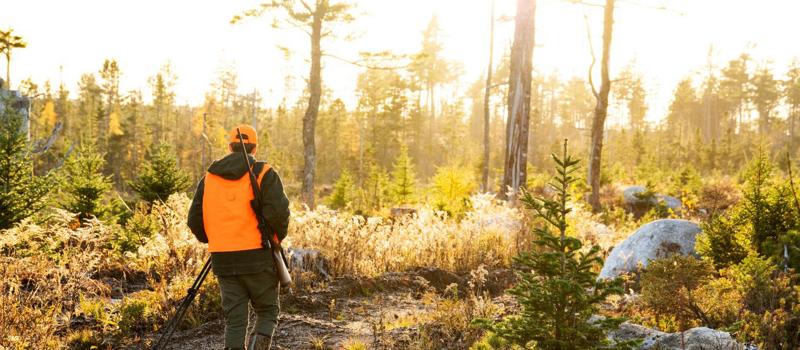Know Your Foe: Tick Prevention and Awareness When Hunting
Posted by Mosquito Squad
July 14, 2023

As any successful hunter knows, success is where preparation and opportunity meet. Regardless of your target or the time of year, all consistently successful hunters spend a great deal of time preparing before their hunt. That preparation comes in the form of scouting, gear maintenance, target practice, calling work, and numerous other steps. One area that is often neglected but arguably one of the most important with preparation and execution is safety. While safety is always top priority as a sportsman, I don’t think many hunters consider vector borne disease when preparing or leaving for their hunt.
Focusing on the main threat: Ticks
Over 95% of vector borne disease in the United States is caused by ticks. According to the CDC, ticks are responsible for vectoring Lyme disease, Powassan virus, Ehrlichiosis, Rocky Mountain Spotted fever, Tularemia, Heartland virus, Rickettsia, Babesiosis, just to name a few. In fact, new and emerging tick-borne diseases continue to be discovered with incidences rising year-on-year for the past decade. What is causing this increase in tick-vectored disease risk? Simply put: the conditions for ticks to thrive are spreading and so are the animals that serve as hosts. Generally, ticks flourish in warm weather and grassy, wooded environments. Changes in climate patterns, such as warmer-than-typical spring and summer temperatures common with the El Nino trend seen in 2023 are allowing continued expansion of tick ranges. For example, the lone star tick (which vectors the new disease southern tick-associated rash illness [STARI]) was usually found only in the Southeast United States but has moved north being found in unexpected places like Michigan, Massachusetts, and New York. This expansion into new geographies is made worse by the abundance of host animals like deer and white-footed mice, both of which ticks feed on. The bottom line is ticks are thriving in the U.S., leading to more bites and tick-borne illnesses.
What you can do to prepare and prevent tick bites
An ounce of prevention is worth a pound of cure. This adage is especially true when it comes to tick prevention. Certainly, exclusion and avoiding ticks is the best way to prevent a bite and possible disease transmission. Many homeowners do this by cutting back high grass and maintain the natural area where managed turf meets wooded areas. In fact, one of the best ways to eliminate ticks in your backyard is by hiring a professional to implement a tick management program. These programs utilize integrative pest management (IPM) to reduce habitat, eliminate hosts such as mice, and control tick populations. Mosquito Squad’s highly effective barrier treatment not only provides a robust defense against mosquitoes but also plays a crucial role in controlling ticks. Our specialized treatment targets areas where ticks are most found, such as tall grasses, shrubs, and leaf litter. Our proven barrier treatment helps create a protective barrier that repels ticks. With Mosquito Squad’s comprehensive approach, you can enjoy peace of mind knowing your outdoor space is not only protected from mosquitoes but also significantly less susceptible to tick infestations.
Unfortunately, when you’re out in the field on a hunt, avoiding ticks simply isn’t possible and even big game reserves seldom employ tick management programs. In these situations, using common sense is the best approach. Always wear long sleeve shirts tucked in and long pants that fit well around appropriate closed toe footwear or that can be tucked into your boots. Specific repellants labeled for ticks can be applied, but inevitably ticks will attach to your clothing. In this situation, if you prepare and treat your clothing with a labeled product (such as permethrin) for fabric treatment you can further protect yourself from exposure.
Following the hunt and proper tick removal
After returning from the field, always undress in a laundry room or garage to prevent ticks from entering the home. Immediately wash your clothing selecting the hottest water setting possible and take a shower. Perform a “tick check” looking for ticks in areas where they often escape notice (joints, folds of skin, etc.). If you do find a tick attached to your body, never attempt to pull it off. This will result in the mouthparts breaking off and continued exposure to the insect saliva with potential for disease transmission. The CDC recommends using clean, fine-tipped tweezers to grasp the tick as close to the skin’s surface as possible. Next, pull upward with steady, even pressure. Don’t twist or jerk the tick; this can cause the mouth-parts to break off and remain in the skin. If this happens, remove the mouthparts with tweezers. If you cannot remove the mouth easily with tweezers, leave it alone and let the skin heal. After removing the tick, thoroughly clean the bite area and your hands with rubbing alcohol or soap and water. Regardless of how a tick removal is executed, always consult with your physician following a tick bite, especially if a rash develops as this may be a sign of disease transmission.
Don’t be the hunter that becomes prey. Plan, prepare, and stay informed. Reducing risk associated with ticks is possible and will lead to a healthier and happier outdoor experience. Stay safe and stay vigilant!
Bio:
Dr. Kurt Vandock is the Vice President of Strategic Growth at Mosquito Squad. He has a PhD in Biochemistry with a focus on Public Health and Parasitology/Entomology. With over 15 years of experience in the Public health field he has authored numerous publications, research articles, and holds several patents. He is an Army veteran and is proud to have served his country deployed during Operation Enduring Freedom. When he’s not helping Mosquito Squad serve as Protectors of Public Health, he enjoys spending time with his Wife and two children enjoying the outdoors as much as possible.
